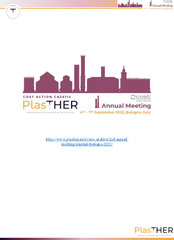Prikaz osnovnih podataka o dokumentu
Modulating chemosensitivity of oral carcinoma to Cisplatin by combination with plasma activated medium on 3D cell models
| dc.creator | Miletić, Maja | |
| dc.creator | Pavlović, Ognjan | |
| dc.creator | Škoro, Nikola | |
| dc.creator | Lazarević, Miloš | |
| dc.creator | Jakovljević, Aleksandar | |
| dc.creator | Mojsilović, Slavko | |
| dc.creator | Puač, Nevena | |
| dc.date.accessioned | 2024-01-30T12:49:28Z | |
| dc.date.available | 2024-01-30T12:49:28Z | |
| dc.date.issued | 2023 | |
| dc.identifier.uri | http://rimi.imi.bg.ac.rs/handle/123456789/1431 | |
| dc.description.abstract | Oral squamous cell carcinoma (OSCC) is one of the most malignant neoplasms of the oral cavity, with a high mortality rate. Since the long-term survival rate of patients diagnosed with OSCC has remained unchanged over the past several decades, it is of utmost importance to discover new treatment modalities or enhance existing ones [1]. Since we previously demonstrated the antitumor efficacy of cold atmospheric pressure plasma (CAP) on OSCC cell lines in a two-dimensional (2D) monolayer cell model, we moved further and tried to explain the mechanism of these cytotoxic events as well as analyze the effect of plasma-activated medium (PAM) in combination with chemotherapy as a gold standard in carcinoma treatment. The modified plasma needle operating at 13.56MHz with He as working gas was used for PAM generation with the distance of 3 mm between liquid surface and the tube and applying different exposure intervals [2]. OSCC cell line (SCC25) was cultivated in 2D or 3D culture systems when regular culture medium was changed for PAM for 24 h before performing assays. PAM treatment showed cytotoxic effects on 2D-cultured OSCC by inducing apoptotic cell death through the activation of the intrinsic caspase pathway. To analyze the combined effect of cisplatin and PAM we used a 3D cell culture approach with OSCC spheroids, as this method reflects more closely the in vivo cellular response to chemotherapeutics [3]. When PAM was combined with the increasing concentrations of cisplatin, the results showed an almost linear dose dependent decrease in OSCC spheroid viability. These arepromising and encouraging results for a potential application of CAP in the treatment of oral carcinoma. By combining the effects of chemotherapeutics with PAM, we developed a new prospect for a possible cancer treatment in which the same or even better antitumor effects could be achieved with lower doses of cytotoxic drugs. Consequently, it means that with lower doses of chemotherapeutics, we could minimize potential side effects associated with the high-dose usage of cytostatics and improve the quality of life for patients with these malignancies. | sr |
| dc.language.iso | en | sr |
| dc.relation | info:eu-repo/grantAgreement/MESTD/inst-2020/200129/RS// | sr |
| dc.relation | info:eu-repo/grantAgreement/MESTD/inst-2020/200024/RS// | sr |
| dc.rights | openAccess | sr |
| dc.source | 2nd Annual Meeting of COST Action CA20114 PlasTHER “Therapeutical applications of cold plasmas”, 4-7 September 2023, Bologna, Italy | sr |
| dc.title | Modulating chemosensitivity of oral carcinoma to Cisplatin by combination with plasma activated medium on 3D cell models | sr |
| dc.type | conferenceObject | sr |
| dc.rights.license | ARR | sr |
| dc.citation.epage | 82 | |
| dc.citation.spage | 82 | |
| dc.identifier.fulltext | http://rimi.imi.bg.ac.rs/bitstream/id/3356/II-AM-PlasTHER.pdf | |
| dc.identifier.rcub | https://hdl.handle.net/21.15107/rcub_rimi_1431 | |
| dc.type.version | publishedVersion | sr |

